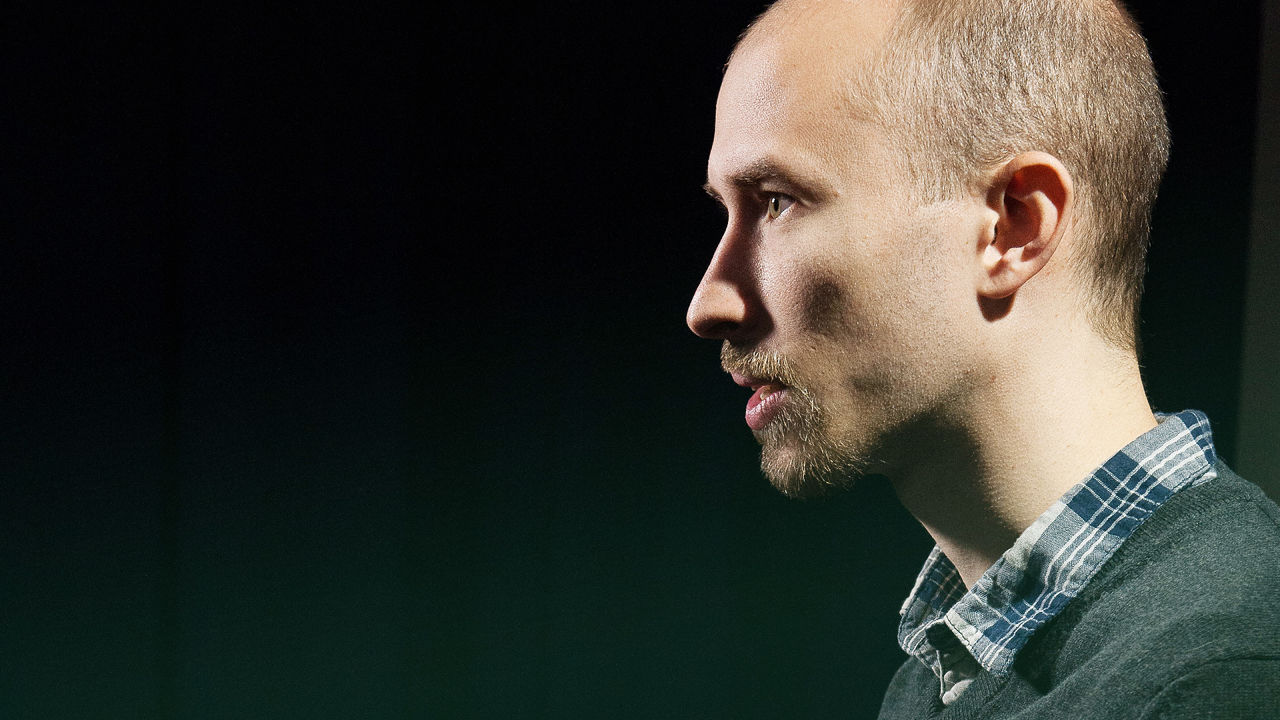How Imgur Became An Image-Sharing, Meme-Generating Megacommunity
“Everybody! Everybody! Sarah is going to give a speech!”
At Imgur’s seventh birthday party at its headquarters in San Francisco’s Jackson Square, a young woman has burst onto the roof deck to alert other young people that something important is about to happen. The Sarah in question is Sarah Schaaf, Imgur’s director of community, and her speech—which she gives while standing on a pool table—consists mostly of brief thanks to members of the Imgur community, some of whom have traveled thousands of miles to attend the event.
At Imgur, nobody has to specify who “Sarah” is, and everything she has to say commands attention. That’s true not only in its offices, but also on its site, where 150 million monthly active users share photos and GIFs, riff on pop culture, make complicated in-jokes, and devise memes which sometimes careen right off of Imgur and onto the web at large. Her role as head of community makes her part den mother, part customer-service rep, and the most important interface between Imgur’s members and the company, which was founded by her little brother Alan in 2009.

By the time Facebook, Twitter, and Instagram reached Imgur’s current size in terms of users—in 2009, 2012, and 2013, respectively—they had long since been household names and polished up their images with a sheen of anodyne respectability. Imgur is different. Despite its scale, it still feels like a secret club. Its members are predominantly (though certainly not exclusively) male and millennial, and are everyday people rather than celebrities or brands. Nobody is there to rack up an impressive count of followers or friends—because the service has no such features.
“I’m obviously biased, but the most special thing about Imgur to me is the community and the way we have this culture around images,” says Sarah. “Once you become a part of that and you understand it, Imgur has this crazy, weird, fun, purposely pixelated personality.”
And yet as a corporate enterprise, Imgur has gradually been evolving into something that looks more like a classic San Francisco startup. After a half-decade as a bootstrapped business, it announced in 2014 that it had received $40 million in funds from Andreessen Horowitz, plus a small investment amount from Reddit. During 2015, its head count doubled to 65, and it recently snagged an Amazon exec to serve as its first VP of product. It’s also been collaborating with brands such as Budweiser, eBay, Old Spice, and PlayStation to integrate marketing into the service—not banner ads, but photos and GIFs which aim to engage its audience by being just as silly as the stuff they upload themselves.

Imgur served up 900 billion image views in 2015; when Alan describes it as “a staple of the Internet,” he isn’t hyping his own creation. But when he launched it in February 2009, it wasn’t a community or the sort of thing that caused big-name venture capitalists to spontaneously write checks. It wasn’t based in San Francisco, and he didn’t even think of it as a startup. At the time, he was a student at Ohio State University, and all he wanted to do was build a better image-hosting service for Reddit users than the ad-infested major players at the time, such as ImageShack, Photobucket, and TinyPIC.
His little project didn’t compress images but offered a few nice frills, including a cropping tool. He paid $7 to register the domain name Imgur.com, and unveiled it to the Reddit community, who knew him as MrGrim.
Three days after its debut, Imgur was already so popular that it maxed out Alan’s supposedly “unlimited” web hosting account, forcing him to move to another server. For months thereafter, it continued to grow so rapidly that he repeatedly had to switch web hosts in search of one that could do the job at a price he could afford. A year after launch, it was serving up almost half a billion images a month.
At first, the service took off not because it did a lot, but because it did so little. “Nobody really wants to put images up on the Internet,” he explains. “What you actually want to do is share it with somebody. So I stripped out everything that other image hosts even had, because when you just get to the point of sharing, what’s really important is speed.”

Because the service made uploading images so fast and simple, its users were uploading interesting stuff in large quantities. So Alan decided to build a gallery of the most popular images—a move that kicked off the site’s transformation into a community.
“I had this insight—that ended up being wrong, by the way—which was, ‘This content’s so good, let’s just have it stand on its own,'” he remembers. “‘I’m not even going to put titles or descriptions or anything on this stuff.’ Turns out that’s actually a dumb idea, because people need context.” With that lesson learned, he added the ability for users to annotate images with text, a feature he initially called “captions.” People held conversations in the captions, so he began calling them “comments.” And he implemented other features, like the ability to up-vote images and pick favorites, which made the site more and more interactive.
“You zoom out from all these thousands of iterations, it’s like, ‘Wow, a community is flowing through all of this engagement, and through these communication features,'” he says. “Now there’s private messaging, there’s notifications, there’s so many things that we built for users, and it’s like, ‘This isn’t image hosting anymore. This is something completely different. This is an image-sharing community, where people are expressing themselves through these images.'”
Enter Sarah
As Imgur gained momentum—still as a one-man company—Alan’s mom played a crucial role in him beginning to think of itself as an actual business. “Her reaction,” he remembers, “was, ‘Holy crap! You’re accepting money from the Internet? You need to incorporate. You need to pay your taxes. You need to protect yourself. You need to trademark your logo.'”
Still self-funding Imgur with money from pro accounts and advertising, Alan relocated to San Francisco in 2011 and began assembling a team. He didn’t need to look far to find a director of community: He hired his sister, Sarah, who had been studying to become a veterinarian. She moved to San Francisco at the end of the year and got busy answering support email, collecting feedback, mingling with members in comments, and running the Imgur presences on Facebook and Twitter.
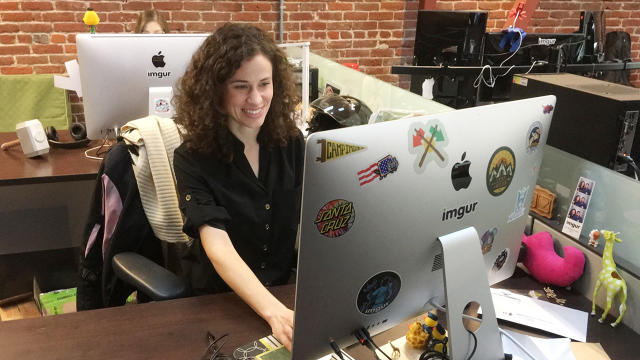
Every meaningful web community has someone—or many someones—to perform those sorts of jobs, but in many cases, those people have low profiles or are downright faceless. Sarah, by contrast, came off as a human being with an emotional attachment to the Imgur community and the individuals who made it up.
“I guess I never had it in my mind, ‘Be a person,'” she says. “I am a person, and I was a person. I love the content on Imgur and I love the community of Imgur so it never felt forced for me to learn how to interact with them. I just did. Their interests reflect my own interests so we’ve always have had something in common.”
Today, Sarah heads up a team with five full-time staffers. But for community members, she remains so synonymous with Imgur the corporate entity that “@sarah pls”—”Sarah, please”—is the shorthand they use when they want to get the company’s attention. And Imgur being Imgur, “@sarah pls” long ago morphed into a meme unto itself and the inspiration for an endless river of images and in-jokes.
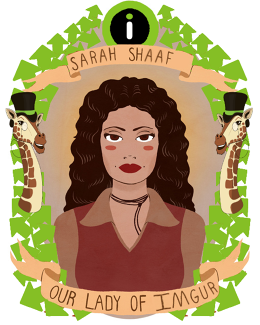
And then there’s the decor at Imgur headquarters. It consists largely of lovingly handcrafted art that members have sent to Sarah, much of which features the top-hatted, monocoled character known as the Imguraffe.
Silly though the Imgur community is, it has always played a critical role in shaping the site’s functionality. When the service was ramping up and Alan was coding it by himself, “I would wake up every morning, and I would have a whole inbox full of user suggestions,” he remembers. “And I would sit down and I’d have my tea and I’d answer them. Then I would I’d plan out my day, and I would start building stuff, based off of what they wanted.”
Sometimes, the community helps not by throwing out ideas, but by pushing back. When Imgur’s mobile apps debuted, for instance, they bypassed the grid view of the service’s browser-based incarnation and plunked users directly into a specific image. “Soon after that, we heard from Imgurians,” Sarah says. “They loved to have that grid view that they were so used to on the desktop, because it gives you a sense of where you are amongst this never-ending stream. You can bounce out, you can pick the thumbnail you like, you can bounce back in. That was an example of where we were like, ‘You guys are so right.'”
“Even the tiniest little details have come, at some point, from a suggestion,” she adds. “You’ll notice if you’re on the desktop version of Imgur and you highlight, it’s a green highlight. That was a suggestion that someone gave us. It’s all these really little things put together that creates this one bigger idea of the Imgurians as the product leaders here. It’s the whole experience of Imgur and that also makes them feel like they’re a part of our journey. Which they are, in the most incredible way.”

Community, Virtual And Otherwise
It’s not a given that anonymous communities like Imgur, which doesn’t tether its members to their real-world identities, will be places of universal goodwill and harmony. Just ask Reddit, which has struggled to deal with its uglier corners. But compared to the Internet at large, Imgur is a surprisingly peaceable, even gentle place. The humor often veers toward the cheerfully raunchy— a little guy known as Dickbutt is so durable a presence that there are multiple allusions to him on the walls at headquarters—but the service isn’t a free-for-all. It bans nudity, porn, and hate speech, and members tend to down-vote trollish comments into oblivion.
“I like to think that people come on Imgur and use their anonymity to be the best versions of themselves,” Sarah says. “That puts people in a vulnerable state which fosters these cool connections that you see among strangers.” Adds Alan,
“We find that they can express themselves more authentically than they can anywhere else, because they don’t have to worry about their personal brand. They don’t have to worry about their crazy aunt seeing what they post. They can be themselves, or be whoever they want to be.”
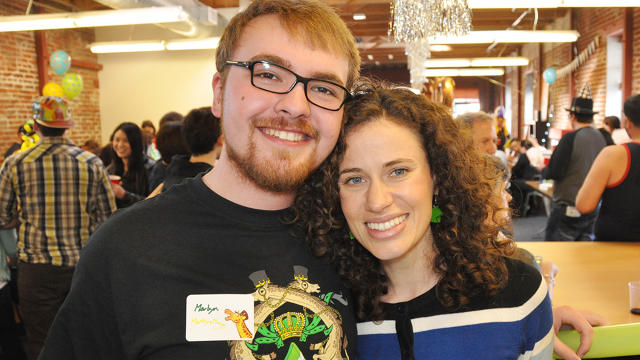
Image-sharing remains the principal form of community on the service, but it’s often a springboard for humanity in other forms. Take the service’s Secret Santa gift exchange, which Imgurian MartynMage spearheaded in 2014 because fellow Imgurians envied a gift swap being held on Reddit. As he remembers, “I thought, ‘Well, if they want it…Why can’t I just do it?'”

As it turned out, the community’s enthusiasm for the idea ran so high that a single person couldn’t do it. “I had over a thousand messages overnight from people wanting to enter,” he says. “I became overwhelmed. I had over 10,000 people who wanted to join and had no idea where to start. I soon posted to Imgur asking for help and literally hundreds of people reached out to help.” It all worked out, went more smoothly in 2015, and led to a Valentine’s Day exchange. And of course, the people who get gifts share pictures of them on Imgur.
Increasingly, the spirit of Imgur is overflowing into the real world. In August 2015, Imgur held Camp Imgur, an in-person festival at a vintage Boy Scout camp in Mendocino, California. More than 500 people attended, making the trek from as far away as Sweden and China. Mendocino isn’t the easiest place to get to, even once you’re already in Northern California. So Imgur rented buses to get attendees to the event. When one of them broke down en route, it became forever known as the strugglebus—and the waylaid passengers bonded in a way they wouldn’t have if getting to Mendocino had been a cakewalk. “We hang out whenever possible, talk all the time,” says Tempuslynn, who was among the temporarily stranded Imgurians. “We all went sailing last month! It’s great.”
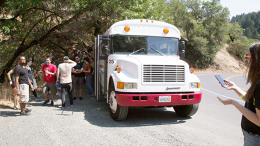
Camp Imgur had no particular goal other than to bring Imgurians together, Sarah says. “You never know what to expect when you plan one of these things. As soon as people started to show up, it was this outgoing group. Men, women, all races, all ages. You would see people playing football next to people playing Dungeons and Dragons. It was an amazing, diverse, awesome group that was one of the first insights for me on what the community looks like in real life.”
Back on the Internet, part of the future of Imgur involves monetizing the community by letting marketers reach them with custom Imgur-style content created by an in-house team. But the company is also thinking of ways to cultivate all the things that image sharing can do beyond providing momentary amusement.
For instance, Imgur, which is itself a pretty great way to kill time, also turns out to be a powerful tool for finding other ways to entertain yourself. “Entertainment is fragmented, but when you browse Imgur, you see these entertaining moments from YouTube, from TV shows,” Alan says. “I got and I watched all of Doctor Who—it was like 12 freaking seasons—because I saw so much content from Doctor Who episodes on Imgur. There’s a show called The League, which I didn’t know existed until I saw it on Imgur. People are just taking these things that you may not know exist, and they’re sharing them with the masses.” The company is working on features for formally leveraging Imgur as a content-discovery engine, he says.
Memes of the sort that Imgur is so good at generating have a primal feel; Alan notes that someone once told him they were the modern equivalent of hieroglyphics. But as huge as the service’s community already is, its next challenge is proving that it can just keep growing, without putting the idiosyncratic, mischievous culture its own members created at risk. Its in-jokes must remain in-jokes—even if the service ends up letting hundreds of millions of new users in on them.
Fast Company , Read Full Story
(72)












